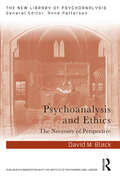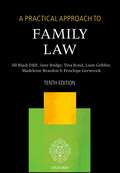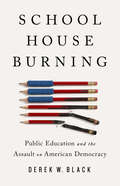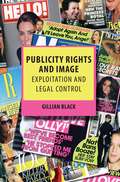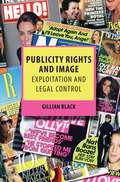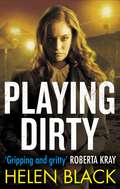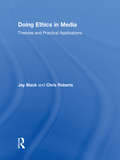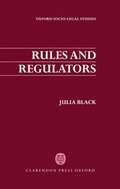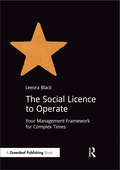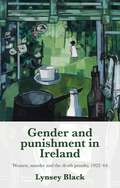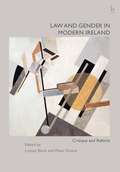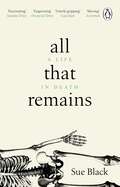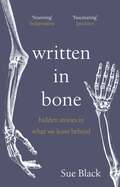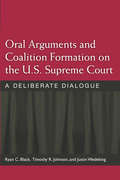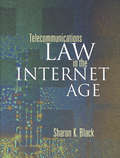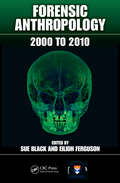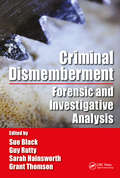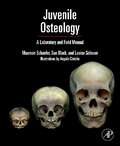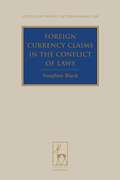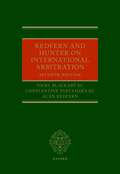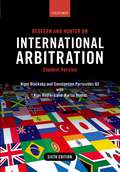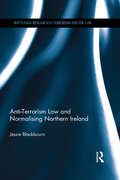- Table View
- List View
Psychoanalysis and Ethics: The Necessity of Perspective (New Library of Psychoanalysis)
by David M. BlackPsychoanalysis and Ethics: The Necessity of Perspective is an attempt to look deeply into the relationship between psychoanalysis and ethics, and in particular into the failure of traditional psychoanalytic thinking to recognise the foundational character of ethical values. In recent years, partly because of the climate crisis, the need for an "ethical turn" in our thinking has been recognised with increasing urgency. Using different historical lenses, and with special reference to the thought of the philosopher Emmanuel Levinas and pioneering American psychoanalysts such as Hans Loewald and Stephen Mitchell, the author discusses the perspectives needed in addition to those of science if the facts of "psychic reality" are to be more adequately recognised. In particular, this book emphasises the importance of a coherent account of the role of ethics in shaping the development both of the individual and of society. Psychoanalysis and Ethics is essential reading for those concerned for the importance of ethics in psychoanalytic practice and theory, and more widely for those seeking to understand the place of ethics and religion in psychological development.
A Practical Approach to Family Law (A Practical Approach)
by The Right Black DBE Jane Bridge Tina Bond Liam Gribbin Madeleine Reardon Penelope GrewcockFamily Law practice has undergone a period of rapid and significant change with the removal of legal aid funding and the establishment of the single Family Court in particular represent major adjustment for those working in the field. A Practical Approach to Family Law provides a clear picture of the law and practice relating to family proceedings in the family court, county courts, and the High Court. Its breadth of coverage and accessible style has made it an essential resource for students and practitioners alike. In an area which continues to evolve this text is a trusted and reliable resource for busy practitioners. It's clear and accessible style make it an ideal tool for both students on LPC and ILEX courses and those in practice. Providing practical advice on the application of legal principles alongside helpful summaries the text gives a detailed overview of a broad range of family law issues. Written by a respected and authoritative team, the tenth edition of A Practical Approach to Family Law has been fully updated to take account of recent developments including the changes to legal aid for family cases and the introduction of the single family court; new rules on the instruction of experts; new approach to care proceedings and court-enforced timetable to avoid delay; and the replacement of residence and contact orders with child arrangements orders. There is also increased coverage of adoption alongside key material on mediation, child support and welfare benefits. Very much a practical guide, the book makes extensive use of examples and key documents to assist the busy practitioner and student. With additional advice on library, information, and professional development resources, A Practical Approach to Family Law provides real assistance in dealing with this dynamic area of law. The A Practical Approach series is the perfect partner for practice work. Each title focuses on one field of the law and provides a comprehensive overview of the subject together with clear, practical advice and tips on issues likely to arise in practice. The books are also an excellent resource for those new to the law, where the expert overview and clear layout promotes clarity and ease of understanding.
Schoolhouse Burning: Public Education and the Assault on American Democracy
by Derek W. BlackThe full-scale assault on public education threatens not just public education but American democracy itselfPublic education as we know it is in trouble. Derek W. Black, a legal scholar and tenacious advocate, shows how major democratic and constitutional developments are intimately linked to the expansion of public education throughout American history. Schoolhouse Burning is grounded in pathbreaking, original research into how the nation, in its infancy, built itself around public education and, following the Civil War, enshrined education as a constitutional right that forever changed the trajectory of our democracy. Public education, alongside the right to vote, was the cornerstone of the recovery of the war-torn nation.Today's current schooling trends--the declining commitment to properly fund public education and the well-financed political agenda to expand vouchers and charter schools--present a major assault on the democratic norms that public education represents and risk undermining one of the unique accomplishments of American society.
Publicity Rights and Image: Exploitation and Legal Control
by Gillian BlackAcademics and practitioners are currently divided on the issues involved in permitting and regulating the commercial exploitation of publicity. 'Publicity' is the practice of using an individual's name, image and reputation to promote products or to provide media coverage, often in gossip magazines and the tabloid press. This book provides a theoretical and multi-jurisdictional review of the nature of publicity practice and its appropriate legal regulation. The book includes a detailed exploration of the justifications advanced in favour of publicity rights and those that are advanced against. Removing the analysis from any one jurisdiction the book examines current academic and judicial perspectives on publicity rights in a range of jurisdictions, drawing out similarities and differences, and revealing a picture of current thinking and practice which is intellectually incoherent. By then clearly defining the practice of publicity and examining justifications for and against, the author is able to bring the nature and shape of the right of publicity into much sharper focus.The book includes a careful consideration of possible limits to any right of publicity, the potential for assigning publicity rights or transferring them post mortem, and whether defences can be offered. The author concludes by arguing for a publicity right which provides a degree of protection for the individual but which is significantly curtailed to recognise valid competing interests.This is a work which will be of interest to academics and practitioners working in the field of publicity, privacy and intellectual property.
Publicity Rights and Image: Exploitation and Legal Control
by Gillian BlackAcademics and practitioners are currently divided on the issues involved in permitting and regulating the commercial exploitation of publicity. 'Publicity' is the practice of using an individual's name, image and reputation to promote products or to provide media coverage, often in gossip magazines and the tabloid press. This book provides a theoretical and multi-jurisdictional review of the nature of publicity practice and its appropriate legal regulation. The book includes a detailed exploration of the justifications advanced in favour of publicity rights and those that are advanced against. Removing the analysis from any one jurisdiction the book examines current academic and judicial perspectives on publicity rights in a range of jurisdictions, drawing out similarities and differences, and revealing a picture of current thinking and practice which is intellectually incoherent. By then clearly defining the practice of publicity and examining justifications for and against, the author is able to bring the nature and shape of the right of publicity into much sharper focus.The book includes a careful consideration of possible limits to any right of publicity, the potential for assigning publicity rights or transferring them post mortem, and whether defences can be offered. The author concludes by arguing for a publicity right which provides a degree of protection for the individual but which is significantly curtailed to recognise valid competing interests.This is a work which will be of interest to academics and practitioners working in the field of publicity, privacy and intellectual property.
Playing Dirty (Liberty Chapman)
by Helen Black'Gripping and gritty, this book will keep you hooked from the first page to the last' Roberta KrayLiberty Greenwood is back.County lines. Blurred lines. Crossed lines.Things are looking up for Liberty Greenwood. She's brokered a deal with the local rival gangster and it looks like the police have finally stopped investigating her. She even has a plan to steer her family away from their criminal activities.But when a spate of violence on the estates points to a hostile takeover bid from a crew from out of the area, Liberty is forced to take decisive and dangerous action - action which ends up with her doing a stint in prison.Meanwhile, Liberty's partner, ex-copper Sol Connolly is recruited to join an off-the-books team who will stop at nothing to infiltrate the new drugs gang, hellbent on sending kids 'up county.'As Liberty and Sol attack the same problem from different angles, who will give out first? And how many people will have to get hurt as they fight for what they each believe in?'The Leeds setting is every bit as gritty as Kray's East End . . . hard as nails!' Peterborough Telegraph
Doing Ethics in Media: Theories and Practical Applications
by Jay Black Chris RobertsDoing Ethics in Media: Theories and Practical Applications is an accessible, comprehensive introduction to media ethics. Its theoretical framework and grounded discussions engage students to think clearly and systematically about dilemmas in the rapidly changing media environment. The 13-chapter text is organized around six decision-making questions— the "5Ws and H" of media ethics. The questions encourage students to articulate the issues; apply codes, policies or laws; consider the needs of stakeholders; sift and sort through conflicting values; integrate philosophic principles; and pose a "test of publicity." Specifically, the questions ask: • What’s your problem? • Why not follow the rules? • Who wins, who loses? • What’s it worth? • Who’s whispering in your ear? • How’s your decision going to look? As they progress through the text, students are encouraged to resolve dozens of practical applications and increasingly complex case studies relating to journalism, new media, advertising, public relations, and entertainment. Other distinctive features include: • Comprehensive materials on classic moral theory and current issues such as truth telling and deception, values, persuasion and propaganda, privacy, diversity, and loyalty. • A user-friendly approach that challenges students to think for themselves rather than imposing answers on them. • Consistent connections between theories and the decision-making challenges posed in the practical applications and case studies. • A companion website with online resources for students, including additional readings and chapter overviews, as well as instructor materials with a test bank, instructor’s manual, sample syllabi and more. www.routledge.com/textbooks/black • A second website with continuously updated examples, case studies, and student writing – www.doingmediaethics.com. Doing Ethics in Media is aimed at undergraduates and graduate students studying media ethics in mass media, journalism, and media studies. It also serves students in rhetoric, popular culture, communication studies, and interdisciplinary social sciences.
Doing Ethics in Media: Theories and Practical Applications
by Jay Black Chris RobertsDoing Ethics in Media: Theories and Practical Applications is an accessible, comprehensive introduction to media ethics. Its theoretical framework and grounded discussions engage students to think clearly and systematically about dilemmas in the rapidly changing media environment. The 13-chapter text is organized around six decision-making questions— the "5Ws and H" of media ethics. The questions encourage students to articulate the issues; apply codes, policies or laws; consider the needs of stakeholders; sift and sort through conflicting values; integrate philosophic principles; and pose a "test of publicity." Specifically, the questions ask: • What’s your problem? • Why not follow the rules? • Who wins, who loses? • What’s it worth? • Who’s whispering in your ear? • How’s your decision going to look? As they progress through the text, students are encouraged to resolve dozens of practical applications and increasingly complex case studies relating to journalism, new media, advertising, public relations, and entertainment. Other distinctive features include: • Comprehensive materials on classic moral theory and current issues such as truth telling and deception, values, persuasion and propaganda, privacy, diversity, and loyalty. • A user-friendly approach that challenges students to think for themselves rather than imposing answers on them. • Consistent connections between theories and the decision-making challenges posed in the practical applications and case studies. • A companion website with online resources for students, including additional readings and chapter overviews, as well as instructor materials with a test bank, instructor’s manual, sample syllabi and more. www.routledge.com/textbooks/black • A second website with continuously updated examples, case studies, and student writing – www.doingmediaethics.com. Doing Ethics in Media is aimed at undergraduates and graduate students studying media ethics in mass media, journalism, and media studies. It also serves students in rhetoric, popular culture, communication studies, and interdisciplinary social sciences.
Rules And Regulators
by Julia BlackJulia Black's book is the first authoritative study of rulemaking in one of the most important areas of economic life: financial services. The books has three main aims: first, to build a jurisprudential and linguistic analysis of rules and interpretation, drawing out the implication of theseanalyses and developing quality proposals for how rules could be used as instruments of regulation. Second, it interprets that analysis and set of proposals with an empirical study of the formation and use of rules in a particular regulatory system: financial services, and third, it evaluates thenature of the rulemaking process. The author's main case study, examining the use of self-regulation in the financial services sector, complements the detailed analysis of rule formation and uses. The book will be an invaluable addition to the libararies of all administrative lawyers and anyone withan interest in the provision and regulation of financial services.
The Social Licence to Operate: Your Management Framework for Complex Times
by Leeora BlackThe "social licence to operate" began as a metaphor to bring attention to the need for companies to earn acceptance from their host communities. Today, it is a necessary management framework for complex times.A social licence strategy is essentially a stakeholder engagement strategy for navigating complex socio-political environments. This book provides the framework, tools and case studies a company needs to create a foundation for truly sustainable community development.This 90-minute guide will enable you to: define the social licence to operate; make the business case for actively managing your social licence to operate; measure the social licence to operate; develop a step-by-step plan to restore, build, maintain and enhance your company’s social licence; and report on your social licence.This book is for managers in any company facing rising social scrutiny due to unwanted social or environmental impacts. You may be working in natural resources, renewable energy, oil and gas, forestry, construction, manufacturing, retail, food processing, pharmaceuticals or any industry that is facing rising stakeholder expectations and increasing criticism.
Gender and punishment in Ireland: Women, murder and the death penalty, 1922–64
by Lynsey BlackGender and punishment in Ireland explores women’s lethal violence in Ireland. Drawing on comprehensive archival research, including government documents, press reporting, the remnants of public opinion and the voices of the women themselves, the book contributes to the burgeoning literature on gender and punishment and women who kill. Engaging with concepts such as ‘double deviance’, chivalry, paternalism and ‘coercive confinement’, the work explores the penal landscape for offending women in postcolonial Ireland, examining in particular the role of the Catholic Church in responses to female deviance. The book is an extensive interdisciplinary treatment of women who kill in Ireland and will be useful to scholars of gender, criminology and history.
Gender and punishment in Ireland: Women, murder and the death penalty, 1922–64
by Lynsey BlackGender and punishment in Ireland explores women’s lethal violence in Ireland. Drawing on comprehensive archival research, including government documents, press reporting, the remnants of public opinion and the voices of the women themselves, the book contributes to the burgeoning literature on gender and punishment and women who kill. Engaging with concepts such as ‘double deviance’, chivalry, paternalism and ‘coercive confinement’, the work explores the penal landscape for offending women in postcolonial Ireland, examining in particular the role of the Catholic Church in responses to female deviance. The book is an extensive interdisciplinary treatment of women who kill in Ireland and will be useful to scholars of gender, criminology and history.
Law and Gender in Modern Ireland: Critique and Reform
by Lynsey Black Peter DunneLaw and Gender in Modern Ireland: Critique and Reform is the first generalist text to tackle the intersection of law and gender in this jurisdiction for over two decades. As such, it could hardly have come at a more opportune moment. The topic of law and gender, perhaps more so than at any other time in Irish history, has assumed a dominant place in political and academic debate. Among scholars and policy-makers alike, the regulation of gendered bodies, and the legal status of sexual and gendered identities, is now a highly visible fault line in public discourse. Debates over reproductive justice (exemplified by the recent referendum to remove the '8th Amendment'), increased rights for lesbian, gay, bisexual and transgender persons (including the public-sanctioned introduction of same-sex marriage) and the historic mistreatment of women and young girls have re-shaped Irish public and political life, and encouraged Irish society to re-examine long-unchallenged gender norms. While many traditional flashpoints remain such as abortion and prostitution/sex work, there are also new questions, including surrogacy and the gendered experience of asylum frameworks, which have emerged. As policy-makers seek to enact reforms, they face a population with increasingly polarised perceptions of gender and a legal structure ill-equipped for modern realities. This edited volume directly addresses modern Irish debates on law and gender. Providing an overview of the existing rules and standards, as well as exploring possible options for reform, the collection stands as an important statement on the law in this jurisdiction, and as an invaluable resource for pursuing gendered social change. While the edited collection applies a doctrinal methodology to explain current statutes, case law and administrative practices, the contributors also invoke critical gender, queer and race perspectives to identify and problematise existing (and potential) challenges. This edited collection is essential reading for all who are interested in law, gender and processes of social change in modern Ireland.
All That Remains: A Life in Death
by Professor Sue Black'Utterly gripping' - The Guardian 'Fascinating' - The Sunday Times 'Moving' - Scotsman 'Engrossing' - Financial Times Sue Black confronts death every day. As a Professor of Anatomy and Forensic Anthropology, she focuses on mortal remains in her lab, at burial sites, at scenes of violence, murder and criminal dismemberment, and when investigating mass fatalities due to war, accident or natural disaster. In All That Remains she reveals the many faces of death she has come to know, using key cases to explore how forensic science has developed, and examining what her life and work has taught her. Do we expect a book about death to be sad? Macabre? Sue's book is neither. There is tragedy, but there is also humour in stories as gripping as the best crime novel. Part memoir, part science, part meditation on death, her book is compassionate, surprisingly funny, and it will make you think about death in a new light. ________ SUE BLACK'S NEW BOOK, WRITTEN IN BONE, IS OUT NOW _________ 'One might expect [this book] to be a grim read but it absolutely isn't. I found it invigorating!' (Andrew Marr, BBC Radio 4 'Start the Week') 'Black's utterly gripping account of her life and career as a professor of anatomy and forensic anthropology manages to be surprisingly life-affirming. As she herself says, it is "as much about life as about death"' (PD Smith Guardian) 'An engrossing memoir . . . an affecting mix of personal and professional' (Erica Wagner, Financial Times) 'A model of how to write about the effect of human evil without losing either objectivity or sensitivity . . . Heartening and anything but morbid . . . Leaves you thinking about what kind of human qualities you value, what kinds of people you actually want to be with' (Rowan Williams, New Statesman) 'For someone whose job is identifying corpses, Sue Black is a cheerful soul . . . All That Remains feels like every episode of 'Silent Witness', pre-fictionalised. Except, you know, really good' (Helen Rumbelow, The Times)
Written In Bone: hidden stories in what we leave behind
by Professor Sue Black'Gripping from the start, Written in Bone is superb' - Dr Richard Shepherd, author of Unnatural CausesFrom the Sunday Times Bestselling author of All That Remains, Sue Black reveals the secrets hidden deep within our bones. Drawing upon her years of research and a wealth of remarkable experience, the world-renowned forensic anthropologist Professor Dame Sue Black takes us on a journey of revelation. From skull to feet, via the face, spine, chest, arms, hands, pelvis and legs, she shows that each part of us has a tale to tell. What we eat, where we go, everything we do leaves a trace, a message that waits patiently for months, years, sometimes centuries, until a forensic anthropologist is called upon to decipher it.Some of this information is easily understood, some holds its secrets tight and needs scientific cajoling to be released. But by carefully piecing together the evidence, the facts of a life can be rebuilt. Limb by limb, case by case - some criminal, some historical, some unaccountably bizarre - Sue Black reconstructs with intimate sensitivity and compassion the hidden stories in what we leave behind. Praise for Sue Black: 'Utterly gripping' - The Guardian 'Fascinating' - The Sunday Times 'Moving' - Scotsman 'Engrossing' - Financial Times
Oral Arguments and Coalition Formation on the U.S. Supreme Court: A Deliberate Dialogue
by Ryan C Black Timothy R. Johnson Justin WedekingThe U.S. Supreme Court, with its controlled, highly institutionalized decision-making practices, provides an ideal environment for studying coalition formation. The process begins during the oral argument stage, which provides the justices with their first opportunity to hear one another's attitudes and concerns specific to a case. This information gathering allows them eventually to form a coalition. In order to uncover the workings of this process, the authors analyze oral argument transcripts from every case decided from 1998 through 2007 as well as the complete collection of notes kept during oral arguments by Justice Lewis F. Powell and Justice Harry A. Blackmun. Both justices clearly monitored their fellow justices' participation in the discussion and used their observations to craft opinions their colleagues would be likely to support. This study represents a major step forward in the understanding of coalition formation, which is a crucial aspect of many areas of political debate and decision making.
Telecommunications Law in the Internet Age (ISSN)
by Sharon K. BlackFor companies in and around the telecommunications field, the past few years have been a time of extraordinary change-technologically and legally. The enacting of the Telecommunications Act of 1996 and the development of international trade agreements have fundamentally changed the environment in which your business operates, creating risks, responsibilities, and opportunities that were not there before.Until now, you'd have had a hard time finding a serious business book that offered any more than a cursory glance at this transformed world. But at last there's a resource you can depend on for in-depth analysis and sound advice. Written in easy-to-understand language, Telecommunications Law in the Internet Age systematically examines the complex interrelationships of new laws, new technologies, and new business practices, and equips you with the practical understanding you need to run your enterprise optimally within today's legal boundaries.* Offers authoritative coverage from a lawyer and telecommunications authority who has been working in the field for over three decades.* Examines telecommunications law in the U.S., at both the federal and state level.* Presents an unparalleled source of information on international trade regulations and their effects on the industry.* Covers the modern telecommunications issues with which most companies are grappling: wireless communication, e-commerce, satellite systems, privacy and encryption, Internet taxation, export controls, intellectual property, spamming, pornography, Internet telephony, extranets, and more.* Provides guidelines for preventing inadvertent violations of telecommunications law.* Offers guidance on fending off legal and illegal attacks by hackers, competitors, and foreign governments.* Helps you do more than understand and obey the law: helps you thrive within it.
Forensic Anthropology: 2000 to 2010
by Sue Black Eilidh FergusonAdvances in our ability to analyse information from skeletal remains and subsequent developments in the field of forensic anthropology make it possible to identify more victims of homicides, mass-fatality disasters, and genocide. Summarizing the vast collection of international literature that has developed over the past decade, Forensic Anthropolo
Criminal Dismemberment: Forensic and Investigative Analysis
by Sue Black Guy Rutty Sarah V. Hainsworth Grant ThomsonCriminal Dismemberment is the first book to examine dismemberment as a phenomenon in the context of criminal acts. While the number of such dismemberment cases in any given country is often small, the notion of dismemberment captures the imagination, often leading many to question the motivations as to why anyone would perpetrate such an unnatural act. The act of dismemberment, in its original form, referred to cutting, tearing, pulling, wrenching or otherwise separating the limbs from a living being as a form a capital punishment. In today’s society, it has become associated most frequently with the criminal act of sectioning the remains of the dead in an attempt to conceal the death and dispose of the remains or make the process of identification of the deceased more difficult to achieve. Drawing on expertise from leading forensic anthropologists, pathologists, and forensic materials engineers, the book brings together much of the literature on criminal dismemberment—viewing it from the investigative, forensic, and social science perspectives. Key features include: Psychological analysis of the perpetrator Detailed examination of case studies, anonymized from recent investigations Difficulties encountered in a dismemberment investigation Tool mark analysis, including knives and saws, accompanied by over 120 detailed, full-color illustrations and photographs Serves as a unique and useful resource in the investigation of dismembered human remains The diverse backgrounds of the contributors offers a thorough account of such topics as the history of dismemberment, the forensic pathology in such cases, the importance of developing a common vocabulary in terminology used, the legal admissibility in dismemberment cases. As such, Criminal Dismemberment will serve as a comprehensive reference for students and practitioners alike.
Criminal Dismemberment: Forensic and Investigative Analysis
by Sue Black Guy Rutty Sarah V. Hainsworth Grant ThomsonCriminal Dismemberment is the first book to examine dismemberment as a phenomenon in the context of criminal acts. While the number of such dismemberment cases in any given country is often small, the notion of dismemberment captures the imagination, often leading many to question the motivations as to why anyone would perpetrate such an unnatural act. The act of dismemberment, in its original form, referred to cutting, tearing, pulling, wrenching or otherwise separating the limbs from a living being as a form a capital punishment. In today’s society, it has become associated most frequently with the criminal act of sectioning the remains of the dead in an attempt to conceal the death and dispose of the remains or make the process of identification of the deceased more difficult to achieve. Drawing on expertise from leading forensic anthropologists, pathologists, and forensic materials engineers, the book brings together much of the literature on criminal dismemberment—viewing it from the investigative, forensic, and social science perspectives. Key features include: Psychological analysis of the perpetrator Detailed examination of case studies, anonymized from recent investigations Difficulties encountered in a dismemberment investigation Tool mark analysis, including knives and saws, accompanied by over 120 detailed, full-color illustrations and photographs Serves as a unique and useful resource in the investigation of dismembered human remains The diverse backgrounds of the contributors offers a thorough account of such topics as the history of dismemberment, the forensic pathology in such cases, the importance of developing a common vocabulary in terminology used, the legal admissibility in dismemberment cases. As such, Criminal Dismemberment will serve as a comprehensive reference for students and practitioners alike.
Juvenile Osteology: A Laboratory and Field Manual
by Sue Black Louise Scheuer Maureen C. SchaeferThe need for a laboratory and field manual to assist with the evaluation of juvenile skeletal material is long overdue. This resource is essential for the practising osteoarchaeologist and forensic anthropologist who requires a quick, reliable and easy-to-use reference to aid in the identification, siding and aging of juvenile osseous material. While excellent reference books on juvenile osteology are currently available, no pre-existing source adequately fills this particular niche in the market. This field manual is designed with practicality as its primary directive. Descriptions of each bone contain 1) morphological characteristics useful for identification, 2) other elements with which the bone may be confused, 2) tips for siding, 3) illustrations of varying developmental phases, 4) data useful for ageing, and 5) a summary of developmental timings. Concise, bullet-style descriptions assist with quick retrieval of information.Unique to this manual is the presentation of data collected from a variety of populations, utilizing a range of observational methods, as an alternative to providing one overall aging summary that is derived from a compilation of many individual sources. This manual provides a host of data on a variety of populations to enable the user to select the reference most applicable to their needs. The final chapter combines information from each bone to provide a summary of developmental changes occurring at different life stages to act as an immediate 'ready reckoner' for the knowledgeable practitioner. It also provides forms useful for documenting juvenile material and diagrams to help with the recognition of commingled juvenile remains. The manual is a must for anyone responsible for the evaluation of juvenile osseous material through dry bone assessment, radiographs, sonograms, and or CT scans.*Identifies every component of the developing skeleton *Provides detailed analysis of juvenile skeletal remains and the development of bone as a tissue *Summarizes key morphological stages in the development of every bone*Provides data on a variety of populations to enable the user to select the reference most applicable to their needs*Focuses on practicality, with direct, bullet style descriptions*Provides forms for documenting juvenile material*Provides diagrams to help with the recognition of commingled juvenile remains*Final chapter provides summary of developmental changes occurring at different life stages to act as an immediate 'ready reckoner' for the practitioner
Foreign Currency Claims in the Conflict of Laws (Studies in Private International Law)
by Vaughan BlackProblems in assessment of damages remain among the most contentious aspects of private law disputes. The assessment exercise becomes particularly difficult when one of the parties asks that damages be assessed in some foreign currency or claims that, even though damages should be assessed in the currency of the forum, foreign exchange losses should form a head of loss.The 1975 decision of the House of Lords in Miliangos v George Frank (Textiles) Ltd was revolutionary in that it permitted English courts to award judgment in a foreign currency. Miliangos has been influential throughout the common law world and courts in the commonwealth and the United States now contemplate awarding damages in currencies other than their own. However, that modernisation has hardly eliminated the problems in this area. When may a judge assess damages in a currency other than that of the forum? If a court elects to assess damages in its own currency, what conversion date should it select in converting from a foreign currency that was relevant to the obligations between the parties? In an age of fluctuating currencies questions of this nature present judges with choices involving significant financial implications.This book takes a comparative look at how common law courts have addressed damages claims when foreign currencies are involved, and at statutory responses to that issue. It describes the practices of UK, Commonwealth and American courts in this field and draws both on principles of private international law and of damages assessment to analyse current practice.
Redfern and Hunter on International Arbitration
by Nigel Blackaby Constantine Partasides Alan RedfernRedfern and Hunter on International Arbitration is an established treatise on the law and practice of international arbitration, the pre-eminent method for the peaceful resolution of disputes in international trade, investment, and commerce. This book serves as an introduction, following the chronology of an arbitration from the drafting of the arbitration agreement right through to the enforcement of the arbitral award. Written by an author team with extensive experience as counsel and abitrators, the book has been read and cited by international lawyers, arbitrators, and judges, and has become a key learning text for teachers, students, and potential arbitrators in colleges and universities across the world. The seventh edition has been significantly revised to incorporate the latest significant developments in the field, includling changes in investor state dispute resolution, leading court decisions on arbitration matters in a wider number of jurisdictions, changes in the 'soft law' of leading international arbitral institutions and of the International Bar Association, and the impact of the COVID-19 pandemic on the practice of international arbitration.
Redfern and Hunter on International Arbitration
by Nigel Blackaby Constantine Partasides QC Alan Redfern Martin HunterThis leading commentary on international commercial arbitration, now in its sixth edition, is an essential guide for arbitrators, lawyers, and students. Based on the authors' extensive experience as counsel and arbitrators, it provides an updated explanation of all elements of the law and practice of arbitration. This text provides an authoritative guide to the international arbitral process, from the drafting of the arbitration agreement to the enforcement of arbitral awards. The sixth edition has been updated to incorporate reference to the latest significant developments in the field such as the new LCIA, ICC and UNCITRAL Rules and new IBA Guidelines. There will also be an increased reference to international arbitral authority and practice from beyond Europe (China, India, and the US). Following the chronology of an arbitration, the book covers applicable laws, arbitration agreements, the establishment and powers of a tribunal, the conduct of proceedings and the role of domestic courts. In addition, it provides an in-depth examination of the award itself, and comments on the special considerations applying to arbitrations brought under investment treaties. It draws on examples of the rules and practice of arbitration at the International Chamber of Commerce, the London Court of International Arbitration, the American Arbitration Association, the International Centre for Settlement of Investment Disputes and the United Nations Commission on International Trade Law.
Anti-Terrorism Law and Normalising Northern Ireland (Routledge Research in Terrorism and the Law)
by Jessie BlackbournThe Northern Ireland peace process has been heralded by those involved as a successful example of transformation from a violent conflict to a peaceful society. This book examines the implementation of the Belfast Agreement in Northern Ireland, and evaluates whether its goal to establish a normal, peaceful society has been fully realised. Using the political and legal status of England, Scotland and Wales as a comparison, Jessie Blackbourn evaluates eight aspects of Northern Ireland which the Agreement aimed to normalise: the contested constitutional status of Northern Ireland, the devolution of power, decommissioning, the removal of emergency laws, demilitarisation, police reform, criminal justice reform, and paramilitary prisoners. The book highlights the historical context which gave rise to the need for a programme of normalisation within the Belfast Agreement with respect to these areas and assesses the extent to which that programme of normalisation has been successfully implemented. By evaluating the implementation of the Belfast Agreement, the book demonstrates the difficulties that transitional or post-conflict states face in attempting to wind back extraordinary counter-terrorism policies after periods of violence have been brought to an end. The book will be of great use to students and researchers concerned with the emergence, evolution and repeal of anti-terrorism laws, and anyone interested in the history of the conflict and peace process in Northern Ireland.
